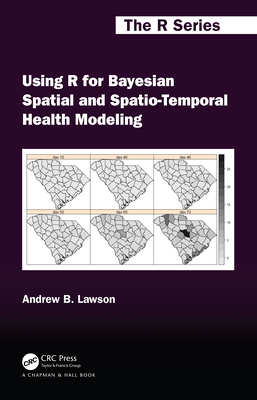Modelling Spatial and Spatial-Temporal Data: A Bayesian Approach (Paperback)
暫譯: 空間與時空數據建模:貝葉斯方法 (平裝本)
Haining, Robert P., Li, Guangquan
- 出版商: CRC
- 出版日期: 2021-09-30
- 售價: $2,240
- 貴賓價: 9.5 折 $2,128
- 語言: 英文
- 頁數: 640
- 裝訂: Quality Paper - also called trade paper
- ISBN: 1032175001
- ISBN-13: 9781032175003
-
相關分類:
機率統計學 Probability-and-statistics
-
其他版本:
Modelling Spatial and Spatial-Temporal Data: A Bayesian Approach
立即出貨 (庫存=1)
買這商品的人也買了...
-
 $1,188Fedora 11 and Red Hat Enterprise Linux Bible (Paperback)
$1,188Fedora 11 and Red Hat Enterprise Linux Bible (Paperback) -
 離散數學 最新修訂版
離散數學 最新修訂版$800$632 -
 Python 設計模式深入解析 (Mastering Python Design Patterns)
Python 設計模式深入解析 (Mastering Python Design Patterns)$360$281 -
 不再聽不懂!圖解網站建置與開發
不再聽不懂!圖解網站建置與開發$450$356 -
 Python 函式庫語法範例字典
Python 函式庫語法範例字典$450$383 -
 演算法之美:隱藏在資料結構背後的原理 (C++版)
演算法之美:隱藏在資料結構背後的原理 (C++版)$650$507 -
 為你自己學 Git
為你自己學 Git$500$425 -
 Hands-On Convolutional Neural Networks with TensorFlow: Solve computer vision problems with modeling in TensorFlow and Python.
Hands-On Convolutional Neural Networks with TensorFlow: Solve computer vision problems with modeling in TensorFlow and Python.$1,300$1,235 -
 Python 技術者們 - 實踐! 帶你一步一腳印由初學到精通
Python 技術者們 - 實踐! 帶你一步一腳印由初學到精通$650$553 -
 Python 與 LINE Bot 機器人全面實戰特訓班 (附203分鐘影音教學/範例程式)
Python 與 LINE Bot 機器人全面實戰特訓班 (附203分鐘影音教學/範例程式)$520$411 -
 Python 技術者們 - 練功!老手帶路教你精通正宗 Python 程式 (The Quick Python Book, 3/e)
Python 技術者們 - 練功!老手帶路教你精通正宗 Python 程式 (The Quick Python Book, 3/e)$780$663 -
 設計師都該懂的包容性網頁 UI/UX 設計模式:知名設計師教你親和性網頁的實作祕密
設計師都該懂的包容性網頁 UI/UX 設計模式:知名設計師教你親和性網頁的實作祕密$450$351 -
 邁向 Linux 工程師之路:Superuser 一定要懂的技術與運用, 2/e (How Linux Works: What Every Superuser Should Know, 2/e)
邁向 Linux 工程師之路:Superuser 一定要懂的技術與運用, 2/e (How Linux Works: What Every Superuser Should Know, 2/e)$600$468 -
 JavaScript 技術手冊
JavaScript 技術手冊$560$476 -
 PowerShell 流程自動化攻略 (Powershell for Sysadmins: A Hands-On Guide to Automating Your Workflow)
PowerShell 流程自動化攻略 (Powershell for Sysadmins: A Hands-On Guide to Automating Your Workflow)$500$425 -
 Deep Learning from the Basics
Deep Learning from the Basics$1,510$1,435 -
 精通資料視覺化 : 用試算表與程式說故事 (Hands-On Data Visualization: Interactive Storytelling from Spreadsheets to Code)
精通資料視覺化 : 用試算表與程式說故事 (Hands-On Data Visualization: Interactive Storytelling from Spreadsheets to Code)$680$537 -
 打下最紮實 AI 基礎不依賴套件:手刻機器學習神經網路穩健前進
打下最紮實 AI 基礎不依賴套件:手刻機器學習神經網路穩健前進$1,200$948 -
 強健的 Python|撰寫潔淨且可維護的程式碼 (Robust Python: Write Clean and Maintainable Code)
強健的 Python|撰寫潔淨且可維護的程式碼 (Robust Python: Write Clean and Maintainable Code)$680$537 -
 Spatial Analysis (Hardcover)
Spatial Analysis (Hardcover)$1,650$1,617 -
 Template Metaprogramming with C++: Learn everything about C++ templates and unlock the power of template metaprogramming (Paperback)
Template Metaprogramming with C++: Learn everything about C++ templates and unlock the power of template metaprogramming (Paperback)$1,830$1,739 -
 邁向 Linux 工程師之路:Superuser 一定要懂的技術與運用, 3/e (How Linux Works : What Every Superuser Should Know, 3/e)
邁向 Linux 工程師之路:Superuser 一定要懂的技術與運用, 3/e (How Linux Works : What Every Superuser Should Know, 3/e)$780$608 -
 精通無瑕程式碼:工程師也能斷捨離!消除複雜度、提升效率的 17個關鍵技法 (The Art of Clean Code: Best Practices to Eliminate Complexity and Simplify Your Life)
精通無瑕程式碼:工程師也能斷捨離!消除複雜度、提升效率的 17個關鍵技法 (The Art of Clean Code: Best Practices to Eliminate Complexity and Simplify Your Life)$600$468 -
 Debunking C++ Myths: Embark on an insightful journey to uncover the truths behind popular C++ myths and misconceptions (Paperback)
Debunking C++ Myths: Embark on an insightful journey to uncover the truths behind popular C++ myths and misconceptions (Paperback)$1,500$1,425 -
 LLM 語意理解與生成技術完全開發 (Hands-On Large Language Models)
LLM 語意理解與生成技術完全開發 (Hands-On Large Language Models)$980$774
相關主題
商品描述
Modelling Spatial and Spatial-Temporal Data: A Bayesian Approach is aimed at statisticians and quantitative social, economic and public health students and researchers who work with small-area spatial and spatial-temporal data. It assumes a grounding in statistical theory up to the standard linear regression model. The book compares both hierarchical and spatial econometric modelling, providing both a reference and a teaching text with exercises in each chapter. The book provides a fully Bayesian, self-contained, treatment of the underlying statistical theory, with chapters dedicated to substantive applications. The book includes WinBUGS code and R code and all datasets are available online.
Part I covers fundamental issues arising when modelling spatial and spatial-temporal data. Part II focuses on modelling cross-sectional spatial data and begins by describing exploratory methods that help guide the modelling process. There are then two theoretical chapters on Bayesian models and a chapter of applications. Two chapters follow on spatial econometric modelling, one describing different models, the other substantive applications. Part III discusses modelling spatial-temporal data, first introducing models for time series data. Exploratory methods for detecting different types of space-time interaction are presented, followed by two chapters on the theory of space-time separable (without space-time interaction) and inseparable (with space-time interaction) models. An applications chapter includes: the evaluation of a policy intervention; analysing the temporal dynamics of crime hotspots; chronic disease surveillance; and testing for evidence of spatial spillovers in the spread of an infectious disease. A final chapter suggests some future directions and challenges.
Robert Haining is Emeritus Professor in Human Geography, University of Cambridge, England. He is the author of Spatial Data Analysis in the Social and Environmental Sciences (1990) and Spatial Data Analysis: Theory and Practice (2003). He is a Fellow of the RGS-IBG and of the Academy of Social Sciences.
Guangquan Li is Senior Lecturer in Statistics in the Department of Mathematics, Physics and Electrical Engineering, Northumbria University, Newcastle, England. His research includes the development and application of Bayesian methods in the social and health sciences. He is a Fellow of the Royal Statistical Society.
商品描述(中文翻譯)
《建模空間及時空數據:貝葉斯方法》旨在針對統計學家以及從事小區域空間和時空數據的定量社會、經濟和公共衛生學生及研究者。該書假設讀者具備統計理論的基礎,至少達到標準線性回歸模型的水平。書中比較了層級和空間計量經濟模型,提供了參考資料和教學文本,每章均附有練習題。該書對基礎統計理論進行了全面的貝葉斯、自足的處理,並專門設有應用章節。書中包含了 WinBUGS 代碼和 R 代碼,所有數據集均可在線獲取。
第一部分涵蓋了建模空間和時空數據時出現的基本問題。第二部分專注於建模橫斷面空間數據,首先描述了幫助指導建模過程的探索性方法。接著有兩個理論章節介紹貝葉斯模型,並有一個應用章節。隨後有兩個章節討論空間計量經濟建模,一個描述不同模型,另一個則是實質應用。第三部分討論時空數據的建模,首先介紹時間序列數據的模型。接著介紹了檢測不同類型時空互動的探索性方法,然後是兩個章節關於可分離(無時空互動)和不可分離(有時空互動)模型的理論。應用章節包括:政策干預的評估;分析犯罪熱點的時間動態;慢性疾病監測;以及檢測傳染病擴散中的空間溢出證據。最後一章建議了一些未來的方向和挑戰。
羅伯特·海寧(Robert Haining)是英國劍橋大學人文地理學的名譽教授。他是《社會與環境科學中的空間數據分析》(1990年)和《空間數據分析:理論與實踐》(2003年)的作者。他是皇家地理學會-國際地理學會的院士及社會科學院的院士。
廣全·李(Guangquan Li)是英國紐卡斯爾北安普頓大學數學、物理與電氣工程系的高級講師。他的研究包括貝葉斯方法在社會和健康科學中的開發與應用。他是皇家統計學會的院士。
作者簡介
Robert Haining is Emeritus Professor in Human Geography, University of Cambridge, England. He is the author of Spatial Data Analysis in the Social and Environmental Sciences (1990) and Spatial Data Analysis: Theory and Practice (2003). He is a Fellow of the RGS-IBG and of the Academy of Social Sciences.
Guangquan Li is Senior Lecturer in Statistics in the Department of Mathematics, Physics and Electrical Engineering, Northumbria University, Newcastle, England. His research includes the development and application of Bayesian methods in the social and health sciences. He is a Fellow of the Royal Statistical Society.
作者簡介(中文翻譯)
羅伯特·海寧是英國劍橋大學人文地理學的名譽教授。他是《社會與環境科學中的空間數據分析》(1990年)和《空間數據分析:理論與實踐》(2003年)的作者。他是皇家地理學會-國際地理學會(RGS-IBG)和社會科學學院的院士。
廣全·李是英國紐卡斯爾的諾森比亞大學數學、物理與電氣工程系的高級講師。他的研究包括貝葉斯方法在社會科學和健康科學中的開發與應用。他是皇家統計學會的院士。











